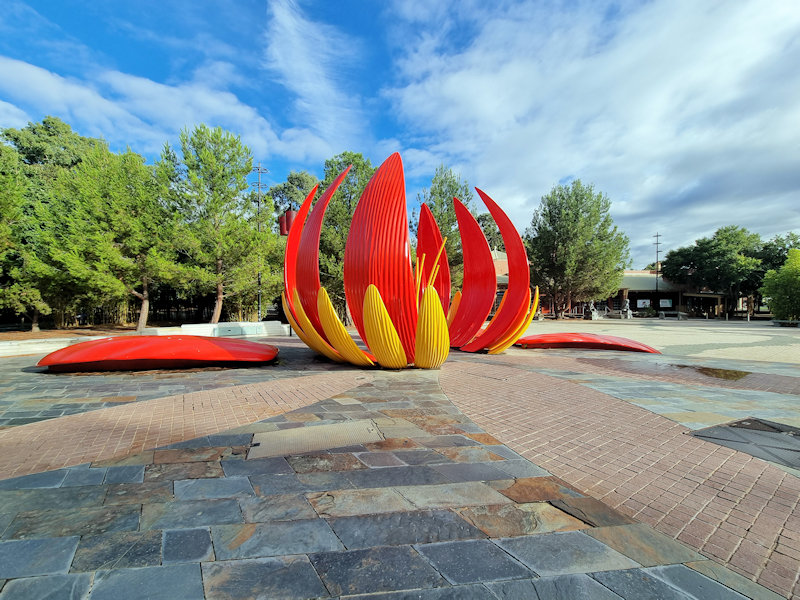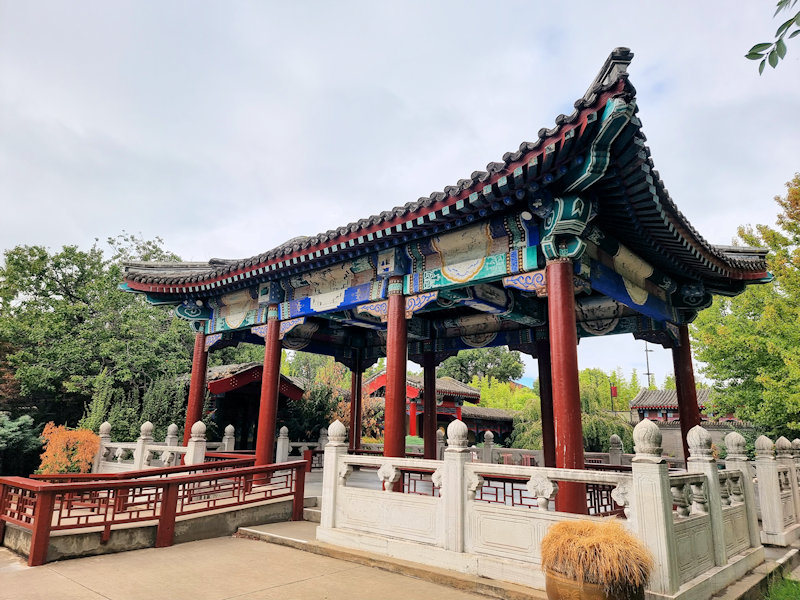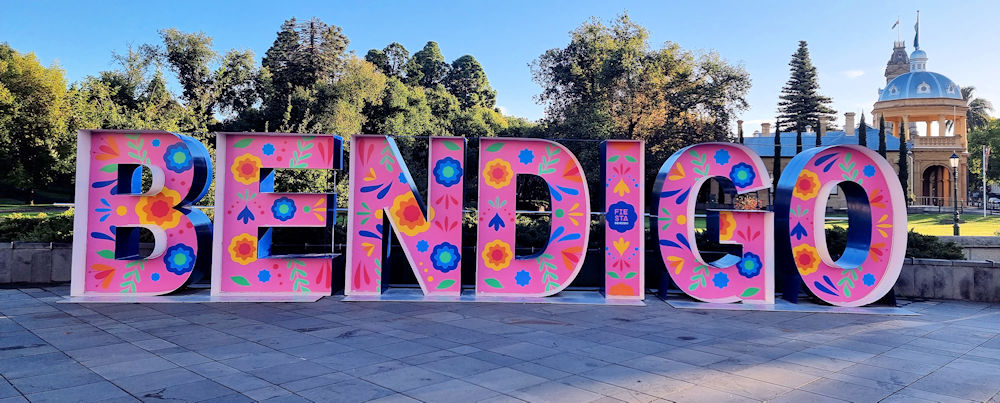Overview & History
Bendigo is a historic regional city located in central Victoria, about 150 km northwest of Melbourne. Originally a sheep station, it became one of the world’s richest goldfields following the discovery of gold in 1851. The resulting gold rush transformed Bendigo into a cosmopolitan city filled with grand architecture, wide boulevards, and ornate public buildings, much of which remains preserved today.
The city’s wealth during the late 19th century helped finance some of Australia’s most elaborate Victorian and Edwardian architecture, churches, civic buildings, and gardens.
What to See and Do in Bendigo
Bendigo Sign

The Bendigo sign is located at the intersection of Pall Mall and View Street. It’s a popular spot for visitors, so we arrived early to get a photos without other people around.
Historical Buildings & Architecture
The gold rush made Bendigo very prosperous, resulting in some magnificent buildings. Most are located in the city centre and within walking distance of each other.
Bendigo Visitor Centre (Former Post Office & Church Precinct)
Located in a magnificent Renaissance Revival building (circa 1887) that once housed the post office, the Visitor Centre also contains a living arts space showcasing regional art and craft and a heritage centre with displays about Bendigo’s past.

Sacred Heart Cathedral
Built in the Gothic Revival style with local sandstone, Sacred Heart Cathedral is one of Australia’s largest and most beautiful cathedrals.

Alexandra Fountain (1881)
Located at Charing Cross, it’s the city’s grandest civic fountain, built with marble and bronze. The fountain is located in Bendigo’s Charing Cross area at the intersection of View Street and Pall Mall. Charing Cross stands at the centre of the city and is one of Bendigo’s busiest and most prominent intersections. The fountain stands opposite the main entrance of Rosalind Park and the Bendigo Sign.
Designed by William Vahland (1828–1915), a local architect and named in honour of Alexandra, Princess of Wales, it opened on 5 July 1881.

Bendigo Law Courts (1896)
Located next to the old Post Office, the Bendigo Law Courts back onto Rosalind Park. The building was built between 1892 and 1896 by the contractors McCulloch and McAlpine and designed by Public Works architect George W. Watson. Constructed in the Victorian Second Empire style, described as reminiscent of an Italianate palazzo it shares a great deal with its neighbouring building, the Bendigo Post Office, also designed and built by Watson, McColloch and McAlpine 10 years earlier. The Law Courts are built of rendered brick and Harcourt Bluestone.

Bendigo Art Gallery (1887)
The Bendigo Art Gallery is one of Australia’s oldest and largest regional galleries. Located in View Street at the intersection with Park Lane, it is very easy to find with its distinctive design.

The Capital Performing Arts Theatre
Designed by Bendigo architects William Vahland and Robert Getzschmann, the building opened in 1873 as a Masonic lodge. In 1890, the Masons refurbished the building to include a dedicated theatre room. Originally called the Mason Theatre, it was renamed the New Britannia in 1912 and then the Capital Theatre in the 1930s. Today the whole building is occupied by the Capital.

Old Fire Station
Also located on View Street and next to the Capital Theatre, the Old Fire Station is now home to the Bendigo Writers’ Council.

Hotel Shamrock
Established in 1854 during the Victorian gold rush, the original building served as a hotel and concert hall, entertaining up to 1,200 guests six nights a week. After a fire in 1857, the hotel was rebuilt with expanded facilities, including thirty bedrooms, private parlours, dining rooms, bars, a smoking saloon, and a bowling alley in the basement.
The current structure, completed in 1897, was designed by architects Vahland and Getzschmann. It is typical of the boom-style architecture with its elaborate façade, mansard roofs, and distinctive corner tower, making it one of Victoria’s finest examples of this style.
The Hotel Shamrock is situated at the corner of Pall Mall and Williamson Street in the heart of Bendigo. It is opposite Rosalind Park and within walking distance of major attractions such as the Bendigo Art Gallery and the Golden Dragon Museum.

Bendigo Military Museum
Unfortunately closed during our visit, the Bendigo Military Museum is not only a museum but a memorial to Central Victorian who participated in war and peacekeeping operations. As of 2025, opening hors are 11:00AM to 3:00 PM on Wednesday, Saturday and Sunday.

St. John’s Presbyterian Church
This church is located on the corner of Forest and MacKenzie Streets, not far from Sacred Heart Cathedral. Originally erected for the Congregational Church in 1890, St John’s was acquired by the Presbyterians in 1949 and opened as St John’s in 1951. The building then became part of the property of the Uniting Church, when it was formed in June 1977. It was subsequently purchased back from the Uniting Church by the remaining St John’s congregation in 1985.

Statues
South African War Memorial
This monument commemorates those who died in service or were killed in action while serving in the South African (Boer) War. Located in front of the Military Museum, it is easy to find.

Discovery of Gold Monument
Commemorating the 1851 discovery of alluvial gold in Bendigo Creek by Mrs Margaret Kennedy, the Discovery of Gold Monument stands between Howard Place, Park Road and the Midland Highway, in front of the Rosalind Park. Standing over nine feet high, the marble figures sit atop a pedestal of Harcourt granite. Constructed in 1906 to the design of Charles Douglas Richardson features the “Spirit of Australia” stooping over a fossicker and dropping gold into his dish as he rinses the alluvial sands.

John Quick Memorial
Located in Queen’s Gardens, this monument is dedicated to Sir John Quick, a prominent Australian lawyer, politician, and one of the authors of the Australian Constitution. He was a leading delegate at the constitutional conventions of the 1890s and served as the federal Member of Parliament for Bendigo from 1901 to 1913.

Statue of George Lansell
Born on 24 August 1823, George Lansell (1823-1906) was mining entrepreneur and businessman, who influenced the gold mining industry in Bendigo. His statue is next to the Military Museum.

Queen Victoria Statue
This statue is unsurprisingly located in Queen’s Gardens on the corner of Pall Mall and View Street.

Chinese Heritage
Bendigo has a fascinating Chinese heritage, which is preserved at the Golden Dragon Museum. Our blog on the museum is here.



Getting to Bendigo
- By car: Around 1 hour 45 minutes’ drive from Melbourne via the Calder Freeway (M79).
- By train: Frequent V/Line services from Melbourne’s Southern Cross Station to Bendigo Station.
- By bus: Regional coaches connect Bendigo to towns across central and northern Victoria.
Our photos are available for purchase on
For other places to visit in Victoria click here

Leave a Reply